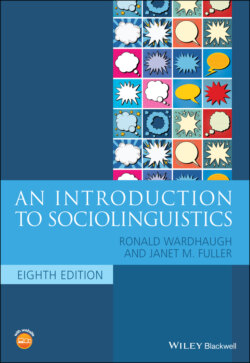Читать книгу An Introduction to Sociolinguistics - Ronald Wardhaugh, Janet M. Fuller - Страница 50
Dialect geography
ОглавлениеWhen a language is recognized as being spoken in different varieties, the issue becomes one of deciding how many varieties and how to classify each variety. Dialect geography is the term used to describe attempts made to map the distributions of various linguistic features so as to show their geographical provenance. For example, in seeking to determine features of the dialects of English and to show their distributions, dialect geographers try to find answers to questions such as the following. Is this an r‐pronouncing area of English, as in words like car and cart, or is it not? What past tense form of drink do speakers prefer? What names do people give to particular objects in the environment, for example, elevator or lift, carousel or roundabout? As discussed in the last chapter, we call such features variables, as there are variable (i.e., varied and changing) ways of realizing them (the variants we discussed in chapter 1). For example, the past tense of drink might be drank or drunk, or the words for the fuel you put in an automobile could be petrol or gas.
Sometimes maps are drawn to show actual boundaries around such variables, boundaries called isoglosses, so as to distinguish an area in which a certain feature is found from areas in which it is absent. When several such isoglosses coincide, the result is sometimes called a dialect boundary. Then we may be tempted to say that speakers on one side of that boundary speak one dialect and speakers on the other side speak a different dialect. We will return to this topic in chapter 5.
However, complicating this picture of dialect regions is the idea of the dialect continuum, in which there is gradual change of the language (Heeringa and Nerbonne 2001); we discussed this above with the example of German and Dutch in the northern regions of those countries. Over large distances the dialects at each end of the continuum may well be mutually unintelligible, although speakers can easily understand people in neighboring areas; but the borders between dialect areas are not clear‐cut lines as implied by the concept of the dialect boundary.
